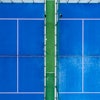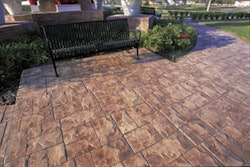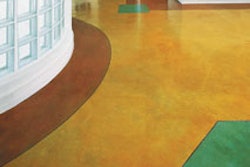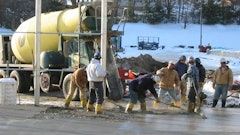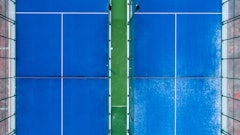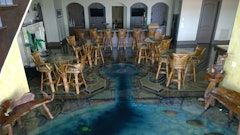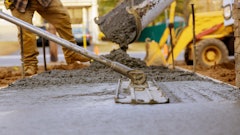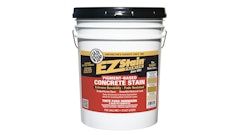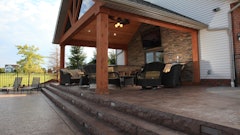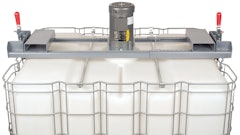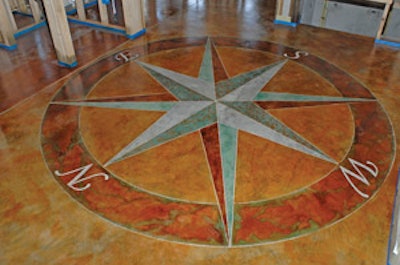
Basic one coat with sealer or multicoat stain applications with decorative saw cuts make up the largest percentage of decorative staining projects, but there is a growing number of clients asking for something more after they see the design possibilities that can be achieved with decorative concrete. If you are currently successfully staining concrete or just starting out, there are many easy specialty techniques you can use to help take your decorative projects to the next level.
Unique effects can be achieved with some common items found around your shop or at the local hardware store. Torn paper, cheesecloth or sea sponges can be used to apply stains or to apply sealers that will act as a resist. A resist is anything that impedes the stain from penetrating into the surface of the concrete substrate. Once the appropriate amount of sealer has been applied and has had sufficient dry time, it forms a barrier that blocks acid-based stains and some other liquids from penetrating the concrete surface. With some creativity and experience using sealers as resists, you can stretch your imagination and create exquisite results. We regularly incorporate veins into the floor designs prior to staining by applying sealer with an artist brush or eyedropper. Other commonly used tools include crumpled up rags and goose feathers. Remember, not all sealers are equal; when using the resist technique, a test panel should be conducted for the appropriate amount of sealer as well as your technique.
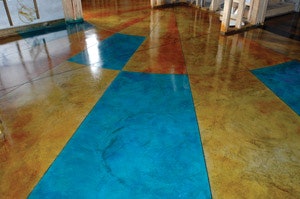
Fertilizer, sawdust, kitty litter or other absorbent materials are just a few more examples of common items you can use to create special effects in your staining. The iron and nitrogen in fertilizers dissolve during the staining process, leaving behind permanent etchings on the floor. Sawdust and kitty litter applied to the concrete surface during the stain application will absorb the stain and leave an outline on the floor.

When concrete dyes are combined with chemical stain, there are no limitations from a predetermined color pallet. Many artisans consider concrete dyes a companion on many chemical stain jobs for a variety of reasons. Dyes can produce bright, vibrant colors such as yellows and blues and can also be mixed together to create your own custom colors. Dyes are often used as an additional accent color over the top of a previously stained and cleaned surface. Many times we will take craft or building paper and rip it, creating a jagged-edged template. We then lay the template down on the concrete and spray dye over the edge of the torn paper creating interesting graphics.
Personalizing your floors with company logos or creative artwork using stains, dyes and faux finishing techniques are yet just another way to further enhance your project. The most commonly used methods to create a personalized logo include engraving, template sandblasting and Modello stencils utilizing skim coats and dyes. Modello manufactures decorative stencils with adhesive backing that can produce extremely high-detail projects. Generally this type of stencil is used only once. In addition, there are companies with sophisticated engraving tools and reusable stencils that are very effective.
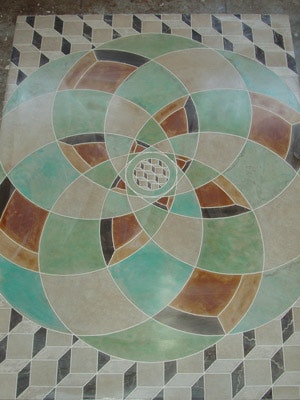
If you are looking for knowledge and inspiration relative to faux finishing, there are plenty of places in which to turn. I have a whole library of faux finishing books that I frequently refer to. You can purchase these books at your local bookstore and have at your fingertips endless techniques and great examples to glean ideas from. I also highly recommend a book on color theory, which will help you understand how colors work together. All this knowledge will help you take your work to the next level.
Bob Harris is the founder and president of the Decorative Concrete Institute, Temple, Ga., which provides hands-on training in architectural concrete. He has personally placed or supervised the placement of more than 3 million sq. ft. of decorative concrete and is the author of a best-selling series of decorative concrete books. For more information, call (877) DCI-8080 or visit www.decorativeconcreteinstitute.com.



